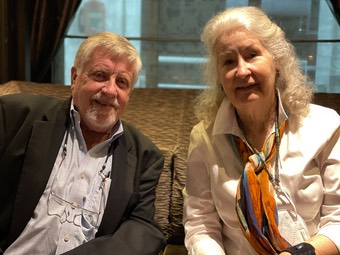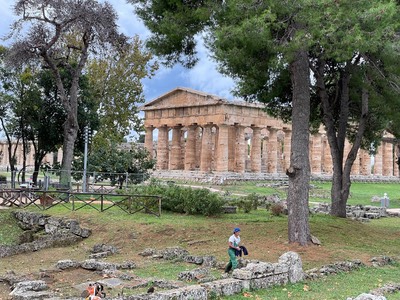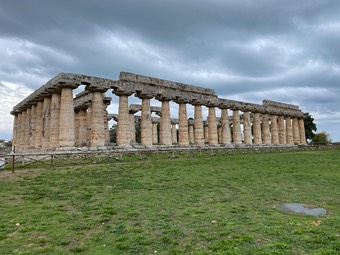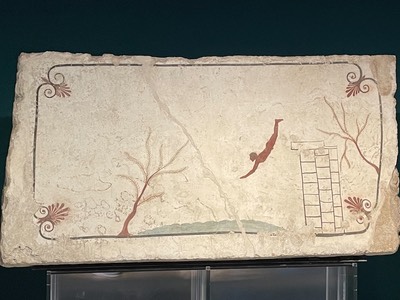We are fortunate to have our friends, Dave and Maureen, on the cruise with us. We enjoy taking excursions and have our evening meals together, plus other ship activities. One of our activities is the trivia contest every day. We call our team the Four Amigos, here we are….


The weather in Salerno started out rainy. As we headed to our bus for the excursion it was raining hard. Fortunately, the rain stopped during our bus ride. Our destination was the ruins of an ancient city (Parco Archeologico de Paestrum Velia). It was established in the 6th century BCE (BC. It was originally Greek, then the Romans conquered it. At some point, it was abandoned until the middle ages.

Our first stop was at the newest of the three temples in the city. It was built in Doric style in 450 BCE. The columns are original (they have not been rebuilt). There is no mortar in the columns just stone on top of stone. That is amazing construction to have survived that long in an earthquake prone region. They built a drainage system under the temple which kept the earth dry and provided a a cushion for earthquakes.

In the second picture you can see the columns better. In a Doric temple, there are typically 6 columns in the front and back and twice that many on the sides. This temple was dedicated to the god of the “new born.”
Note the umbrellas in front of the temple. It may have been drizzling a bit, but the weather was not bad.
The second temple that we saw (the two photos below) was the oldest, built between 560 and 520 BCE. (The scientist in Chuck’s head wonder how they can date the start and the end that precisely.)
This temple is unusual because it has an odd number of columns (9 in the front and 18 on the sides). The archeologists have decided it must have been a temple in spite of that oddity.



The city walls had 4 gates, and 6 watch towers. The sea was on the west. Now ,the sea is 6 km away.
The main square suggests that 10,000 to 12,000 people lived in the city.
There was an indoor market and an assembly hall. The assembly hall is where the community gathered to discuss and make decisions. When the Romans conquered the city, they didn’t need the hall because there were no decisions to be made. So they filled in hall with dirt and erected a statue—a clear message to the people that the Romans were in charge.

The city had a gymnasium and swimming pool. There was an amphitheater where they held fights and games. Blood was spilled as the games were barbaric. The amphitheater could hold 7,000 to 8,000 people.
The third temple was built around 500 BCE. They seemed to build a temple every 50 years. You’ve seen enough pictures of columns. It is similar to the first temple—Doric, 6 by 12 columns. It eventually became a Catholic church.
In the museum we saw paintings on stone that were part of the funerals of rich people. Sometimes coins were found in the mouths of the skeletons that were found. The coin served as cash to buy a ticket to the other side. The most famous of the paintings has been nicknamed the “diving tomb”.
We are willing to bet that if you read all of this, you learned more than you wanted to know about Roman ruins. <GRIN>.
